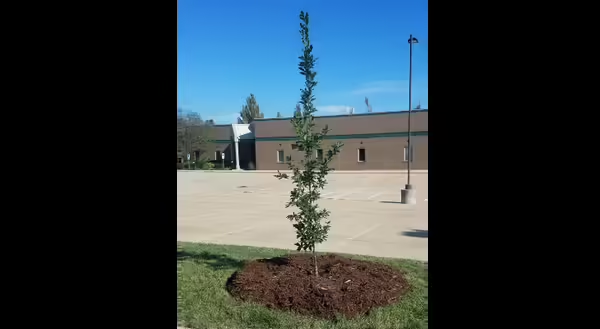
Spring is a time of an awakening plant world full of blooms and endless possibilities for the coming growing season. It’s a time that many of us think about updating our landscaping, making it the most popular time of year to plant trees and shrubs.
When you combine the mild temperatures and bountiful rainfall of spring, it creates a wonderful planting opportunity, supporting newly planted trees and shrubs well by setting them up to thrive in the coming growing season. However, at the time of spring planting, surrounded by all the optimism that pleasant spring weather brings, we often fail to think about the harsh summer conditions ahead for our new tree. No matter how early we plant or how favorable spring weather may be, all newly planted trees are in transplant shock for several years following planting and drought stress during the first summer is often a critical factor in their long term survival.
Past research has shown high mortality rates and short lifespans for street trees planted in the city right-of-way, or boulevard, by homeowners or municipalities themselves. A few highly cited research papers from the late 1980’s and early 1990’s report shockingly low average lifespans of urban street trees at only 7-13 years. More recent papers have identified somewhat longer average lifespans for current generations of street trees, suggesting an average closer to 30 years, which I believe can be attributed to overall better tree care practices in recent decades.
Street trees are certainly subjected to harshest urban conditions and represent the “worst-case scenario.” Research looking at trees planted in home landscapes and parks suggests a much higher survival rate and much longer expected life. However, most of this research points toward the immediate five years after planting as the most critical period in an urban tree’s life, reinforcing the vital role of proper planting and follow-up care.
All newly planted trees are in state of shock until they become “established” at their new planting site. This transplant shock has been shown to persist for 2-3 years in most trees, and it is generally true to assume that the larger the tree, the longer the transplant shock, sometimes extending it up to 5 years.
What is the major hurdle that a tree must clear to overcome transplant shock and become “established”? Most of the answer lies in root development and many of the unseen things that occur underground. Since a balled and burlapped or containerized tree has a small amount of roots compared to above-ground plant parts, the crux of tree establishment lies in the development of an adequate root system to support the plant.
Much of the available research on tree survival has failed to address the unique and often wide-ranging soil conditions present at urban planting sites. It is just something that is simply impossible to study on large scale, although research has addressed it on a smaller scale, identifying soil conditions as a major factor in urban tree health.
It really pays to assess the soil profile as you dig your planting hole. Does it appear to be undisturbed soil in a more natural state with gradually changing colors in layers horizontal to the soil surface, or does it appear to be a mixture of soil with wide-ranging color, indicative of soil disturbance from construction and other urban activities? Does it seem dense and compacted or loose and easy to shovel?
Although trees don’t have high soil nutrient demands, like a tomato plant, the texture and structure of soil are quite important to ensure adequate air and water exchange for root development. If you feel like the soil in your planting hole has a poor composition, consider adding amended soil. Also, dig your planting hole shallow and very wide, as wide as you deem practical. The loosened backfill in your planting hole provides a wonderful space for root development compared to the relatively compacted soil outside the area you dug.
Proper planting depth has also been identified as a major factor in tree survival. Ensure that your tree is planted at the proper depth by identifying the root collar before digging a hole. The root collar is the area at the base of a tree trunk where the trunk flares, or tapers, outward as it transitions to root tissue. Many times the root collar is not at the surface level of the pot or root ball, making it necessary to dig down in search of this structure. Set the depth of your planting hole based on the location of the tree’s root collar; it may be much shallower than you would think.
After backfilling the hole around your tree, be sure to add 2-4 inches of mulch on the soil surface to help retain soil moisture in the hotter part of summer. As we get into late June and July, be prepared to provide water for your tree any time we have not received 1-2 inches of rainfall in a given week. It is preferred to water for long periods once a week as opposed to short duration, many times a week since this mimics our natural rainfall.
Plan to mulch and water your tree carefully next year, and possibly the following year for larger trees, to be sure it becomes established in its new home and doesn’t just become “one of the numbers” as so many urban trees do each year.
For more detailed information on tree planting and aftercare, visit the International Society of Arboriculture’s website, available by clicking here. It features a “Tree Owner Information” webpage with great information on all aspects of tree care.